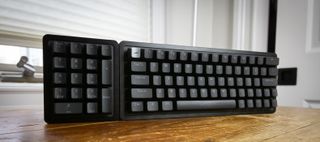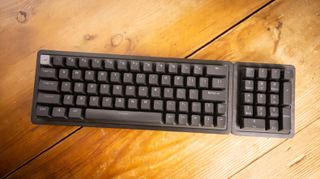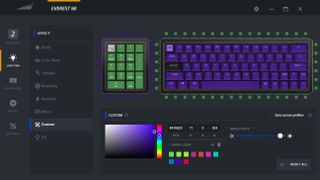Tom's Hardware Verdict
Unlike most pre-built 60 percent mechanical keyboards, the Mountain Everest 60 has buttery-smooth pre-lubed switches, a well-damped case, and a detachable numpad. If you're after a compact gaming board, you can't go wrong here.
Pros
- +
Fantastic switches
- +
Per-key RGB
- +
Aluminum face plate
- +
Well-dampened
- +
Hot-swap PCB
- +
3x USB Type-C ports
- +
Adjustable numpad (sold separately)
- +
Double-shot PBT Keycaps
Cons
- -
1u right shift key
- -
Occasional software bugs
Why you can trust Tom's Hardware
The gaming keyboard market is saturated with full-size and tenkeyless (TKL) boards, but 60 percent boards, the smallest standard keyboard size, have traditionally been less popular in the gaming space. That's because the 60 percent layout usually sacrifices arrow keys as well as the numpad for size. Not the Mountain Everest 60, however — this 60 percent mechanical gaming keyboard has both arrow keys and the option to add a detachable numpad, making it perfect for gamers who want to save space but still have the option of extra keys. It's also quite customizable.
The Mountain Everest 60 comes with three different switch options and 11 different keycap color combos. Our review unit came with Mountain Linear 45 switches, black keycaps, and included a numpad. The keyboard alone starts at $140 and the keyboard and numpad set starts at $190.
Mountain Everest 60 Specifications
| Switches | Mountain Linear 45 |
| Lighting | Per-key |
| Onboard Storage | 5 Profiles |
| Media Keys | Yes, with FN |
| Connectivity | USB Type-C to Type-A |
| Cable | 6-feet, braided |
| Additional Ports | 3x USB Type-C |
| Keycaps | Double-shot PBT |
| Software | Mountain Base Camp |
| Dimensions (LxWxH) | 307.2 x 115 x 46.44 |
| Weight | 1.7 pounds |
Design

Unlike other 60 percent mechanical keyboards I’ve used, the Mountain Everest 60 features arrow keys and the option to connect a numpad. Adding arrow keys to the Everest 60 is a bold move by Mountain — it’s not easy to pull off without sacrificing usability. I love smaller keyboards, but the main reason I stepped up to a 65 percent keyboard from a 60 percent layout was because I wanted arrow keys.
Mountain’s choice to add arrow keys to the Everest 60 is a bold choice, but it’s not necessarily all good. To fit arrow keys on the board, Mountain reduced the right shift, function, and control keys to 1u (one unit, or the standard size of a letter key). I was mostly able to get used to the 1u right shift after a few days of using the Everest 60, but I still ended up looking down at the board from time to time to make sure I wasn’t pressing the forward-slash key. I understand that Mountain wanted to differentiate itself from other 60 percent boards with arrow keys such as the Freebird60 — but I prefer the Freebird60’s layout, which has a 1.75u right shift key.
My review unit came with Mountain’s factory-lubed Linear 45 switches. I didn’t expect much from factory-lubed switches, but these were so smooth I would believe it if you told me they were hand-lubed. I was very impressed with these switches, and they’re a great choice for those looking for affordable, pre-lubed linear switches. The Linear 45s are also a great alternative to those looking for something smoother than Cherry MX Reds, because they have the same 45g spring weight.
Some companies just slap a layer of foam in the case and call it a day when it comes to sound-damping, but not Mountain. The Everest features a silicone layer at the bottom of the case and two layers of foam, one underneath and one above the PCB. This sound-dampening might seem over the top, but it is effective: I heard no pinging, even when I listened closely for it. But those expecting the solid, premium feel of a metal housing should know that the Everest 60 is almost entirely made of plastic, except for the edges of the board which are brushed aluminum.
This wouldn’t be a proper gaming keyboard without per-key RGB, which the Everest 60 has. The keyboard’s RGB impressed me — especially on the edges — but the keycaps weren’t the best for shine-through. When I set the LEDs to white, the keycaps made the lighting look closer to light pink. The per-key RGB also wasn’t super easy to access because of software issues, which I’ll discuss a little later.
The Everest 60’s keycaps are double-shot PBT, which are more durable than dye-sub keycaps. I enjoyed the feel of these PBT caps. They aren’t coarse like some of the PBT caps I’ve seen on other gaming keyboards. The keycaps are good quality in terms of durability, but the alphas and modifiers look a little blurry, especially on the caps lock key specifically.
The Everest 60’s most unique selling point is the optional numpad, which can be attached to either the left or right side of the board — a feature that's quite rare and mostly has only existed on much larger keyboards, like Asus' Claymore and Microsoft's Sidewinder line from more than a decade ago. The numpad costs an additional $50 and cannot be used alone; it needs to be attached to the Everest 60 to work.
Attaching the numpad is easy: Slide a tab underneath the pad in the appropriate direction that aligns with the Everest, and click it in like you would any Type-C connector. When the numpad is attached, it just kind of sags there unless it’s on a desk. This might sound like nit-picking — especially because keyboards spend most of their time sitting on desks — but it seems like it could be precarious when you move the keyboard. I wouldn’t be surprised if the numpad just fell off one day as you lifted it off your desk, damaging the connection. You’ll need to remember to disconnect the numpad when you want to move the board around.
You might be wondering why someone would want a numpad if they’re buying a 60 percent keyboard in the first place. I like smaller keyboards, but I do occasionally need to input data — a numpad helped a lot when I was adding data to Microsoft Excel for keyboard and case reviews, for example. If data entry isn’t your thing, you could also use the numpad as a macro pad, which is why you might want to attach it to the left side of the keyboard.
The optional numpad isn’t the only neat feature on the Everest 60. This keyboard also has three USB Type-C ports on the front (more than most motherboards), magnetic pucks for raising the board up, a braided cable, and it comes with a switch/keycap puller and an extra keycap with the Mountain logo on it.
Typing Experience on the Mountain Everest 60

I’ve already talked about the Everest 60’s 1u right shift key, and how — even though I got somewhat comfortable with it — I never felt 100 percent confident I was pressing the correct key during my testing. The small shift key wasn’t the only thing that took time to get used to: Using the numpad on the left side felt like I was learning to type all over again. (Of course, this wasn’t Mountain’s fault — I was just curious what it’d feel like to use a lefty numpad.) After struggling for a bit, I moved the numpad back to the right side and it felt fine. A left-side numpad is much better suited to gaming as a macro pad.
While the Everest 60’s factory-lubed switches felt hand-lubed and ultra-smooth, I can’t say the same for the stabilizers. The lubricant started to settle after about a day and this made the stabilizer bars rattle a bit more than I’d like. This isn’t a major concern, though — I’ve experienced much worse stabilizer rattle in mechanical keyboards that cost twice as much.
Overall, the typing experience on the Mountain Everest 60 was fantastic, especially for a stock gaming keyboard. The pre-lubed switches were some of the best that I’ve tried, the sound dampening was top-tier, and while there was some stabilizer rattle, it was nowhere near as bad as I’ve seen on other boards.
Gaming Experience on the Mountain Everest 60
Treyarch and Activision finally broke their silence about the future of Call of Duty’s zombie mode, so I decided to jump back into Call of Duty: Black Ops Cold War to destroy some zombies.
I prefer a smaller keyboard for casual gaming, because it takes up less space and I only use W,A,S,D and a few other keys. The Linear 45 switches were nicely in the middle — not too heavy, like the Asus ROG NX Blue switches, or too light, like the Cherry MX Speed Silver switches. These switches are not like most of the switches you’ll find in gaming keyboards. They’re much smoother than stock Cherry MX or Gateron switches; the Linear 45 switches are exciting to see in a pre-built gaming keyboard. The Everest 60 also has a game mode feature, which disables shift + tab, alt + F4, the Windows key, and alt + tab.
Software
The Mountain Everest 60 is powered by the company's Mountain Base Camp software, which allows you to adjust the RGB on a per-key basis, record macros, and remap keys. Mountain Base Camp does its job pretty well, however there were multiple instances in my testing in which it froze. Booting into Base Camp wasn’t the issue; I usually ran into the spinning wheel of death when I opened the macro recording or lighting customization tab. Freezing aside, Base Camp is simple and easy to use, and doesn’t overwhelm you with an absurd number of unnecessary features.

When the software isn’t frozen, the RGB customization is highly-detailed: Even the LEDs around the edge of theboard are adjustable.
Bottom Line

The Mountain Everest 60 is a fantastic mechanical keyboard. I wasn’t too keen on the 1u right shift key, but I’m sure I’d be able to get used to it with more use (and if you don’t use the right shift key, this may not be an issue at all). The detachable numpad is an interesting and pretty usable concept, and being able to attach it to either side of the keyboard makes it especially versatile as a numpad or a macro pad.
I also have to commend Mountain for the switches, which are by far the smoothest linear switches I’ve seen in a pre-built gaming board. There's so much good going on with this keyboard that I almost forgot to mention that the Everest 60 has a hot-swap PCB so you can change up the switches if you want. But the Linear 45 switches I tested are so good that it didn’t even occur to me to swap them out.

Myles Goldman is a freelance writer for Tom's Hardware US. He reviews keyboards and cases.
-
Occasional software bugs yeah never mind I don’t have time for that. Ain’t nobody got time for thatReply
Neat idea. I would probably use it without the software anyway because I hate the custom software that comes with keyboards

